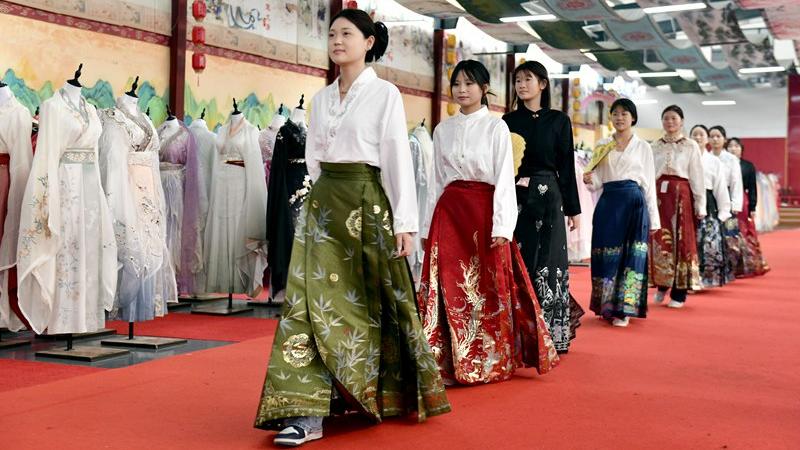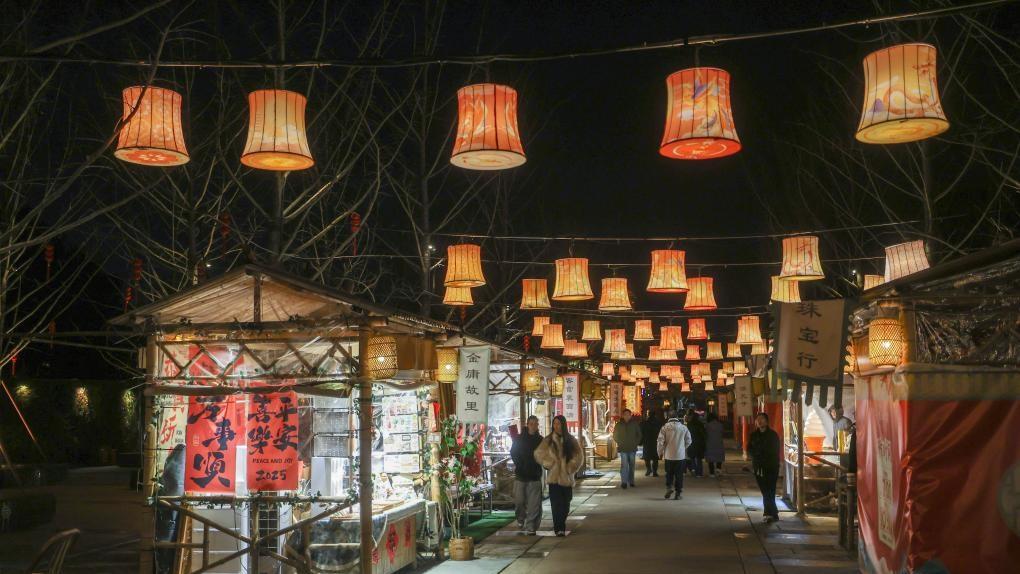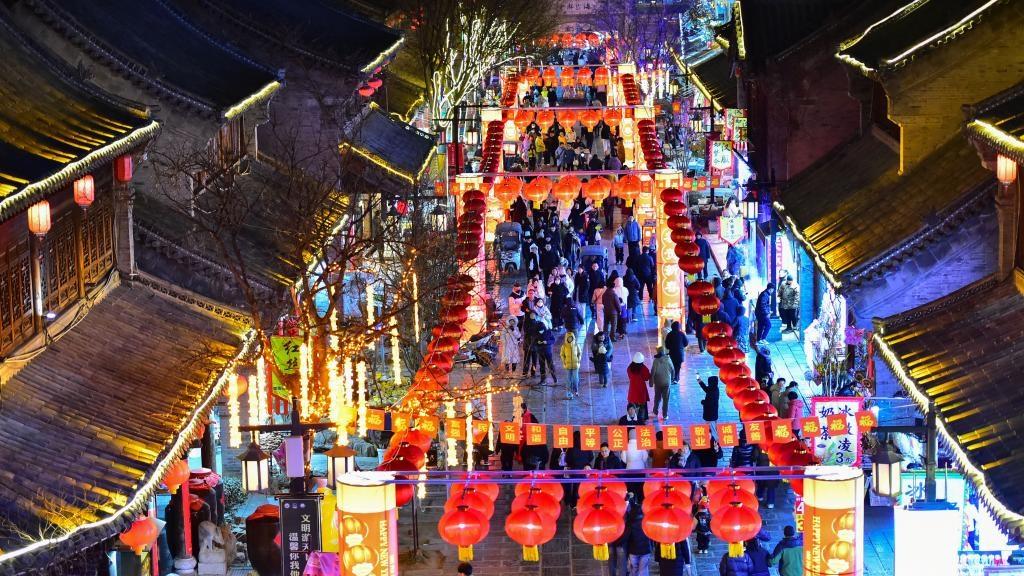China's Gen-Z infuses Chinese New Year celebrations with youthful vitality
Exploring intangible cultural heritage markets, buying creative New Year gifts, wearing Hanfu for travel photography, and sending emoji "electronic New Year greetings" are just some of the new customs emerging as younger generations put their own spin on the Chinese New Year, or Spring Festival.
In the first Spring Festival after its successful addition to the UNESCO list of intangible cultural heritage, Generation Z is passing on excellent traditional culture while experiencing the timeless joy of the Chinese New Year.
Snake-themed emojis help extend festive greetings
Sending emojis with auspicious meanings on messaging apps has become a new trend to extend festive greetings. This year, many are using a series of emojis called "Jiujiushe" to share New Year wishes.
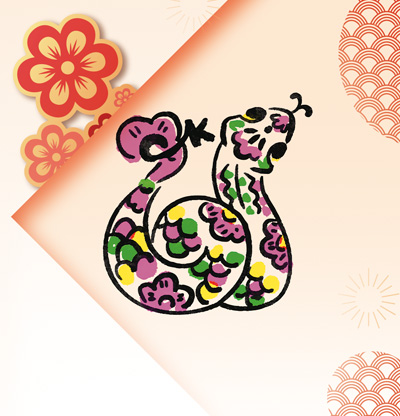
Photo shows an emoji of the "Jiujiushe" series. (Photo courtesy of the designing team led by Professor Yuan Bo from the Academy of Arts & Design, Tsinghua University)
The emojis were designed by Professor Yuan Bo's team from the Academy of Arts & Design, Tsinghua University, which drew inspiration from traditional Chinese clay sculptures, particularly the clay figurines of Fengxiang county, northwest China's Shaanxi Province. Featuring simple strokes, vibrant colors, and rounded and lively forms, the designs exude a strong folk-art aesthetic.
"My relatives and friends all love it," said Yang Jieyu, a graduate student born after 2000 and also a member of the design team. "Emojis help us express our feelings on social media platforms, and also serve as a trendy medium for promoting traditional culture."

Yang Jieyu shows an image of the "Jiujiushe" series. (Photo courtesy of the interviewee)
"Using these clay sculpture-themed emojis allows people to enjoy both the festive joy of the Spring Festival and China's rich folk culture," said Yang. She added that people have asked her about the traditional clay sculpture techniques that inspired the emojis, noting how "traditional culture is being revitalized on social media."
Young apprentice helps tourists experience tie-dyeing art
During the eight-day holiday, many tourists visited the Puzhen Bai Ethnic Group Tie-dyeing Museum in Zhoucheng village, Xizhou township, Dali city, Dali Bai Autonomous Prefecture of southwest China's Yunnan Province, to try the traditional folk technique of the Bai ethnic group and buy relevant products. Zhao Xin, an apprentice born after 2000, guided visitors.
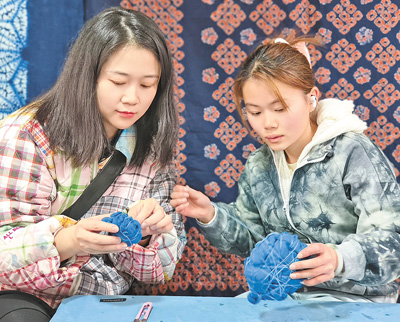
Zhao Xin (R) guides a tourist to make a tie-dye artwork in Puzhen Bai Ethnic Group Tie-dyeing Museum in Zhoucheng village, Xizhou township, Dali city, Dali Bai Autonomous Prefecture of southwest China's Yunnan Province. (Photo/Li Xin)
Zhao has been studying the craftsmanship, which was listed as part of China's national intangible cultural heritage in 2006, for three years. "I was mesmerized by experienced elders adeptly using needles and threads like ink to create intricate designs on white cloth," said Zhao.
"This is isatis root, one of the primary plant dyes for tie-dyeing," Zhao explained to tourists. College student Zhang Qingqing and some friends traveled from Kunming specifically to experience tie-dyeing. "This experience allows me to engage in this traditional craft and relax," Zhang said. "I want to create sunflowers and present them to my parents as New Year gifts."
Zhao added that an increasing number of young individuals come here to try the ancient art, saying that, "the making of the artwork may take some time, but within this slow art, there is Chinese traditional culture. When visitors open the cloth, they don't just get their works—they receive healing and a sense of being emotionally touched."
Young man serves as the lead organizer of fish lantern parade
From the 13th to the 16th of the first month on the Chinese lunar calendar, a fish lantern parade is held in Wangmantian village, Shexian county, Huangshan city of east China's Anhui Province, as part of the traditional celebration for the Chinese New Year. Villagers carry handmade fish lanterns in a lively parade, praying for favorable weather and a bountiful year ahead. Spanning over six centuries, this tradition is recognized as a provincial-level intangible cultural heritage item.
Born in 2002, Wang Wenquan has served as the lead organizer, or Fish Head, of the celebration for many years, responsible for fundraising, procurement, galvanizing the villagers to make, carry and repair lanterns.
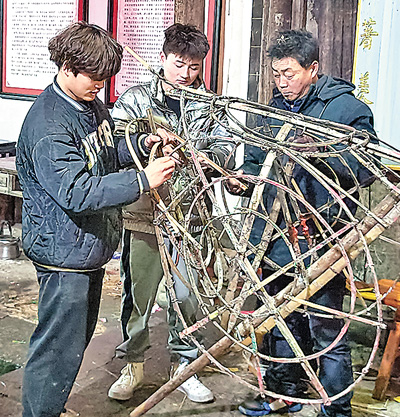
Wang Wenquan (middle) and two villagers make the frame of a fish lantern in Wangmantian village, Shexian county, Huangshan city of east China's Anhui Province. (Photo courtesy of the publicity department of the Communist Party of China Shexian county committee)
"The first time I became Fish Head in 2018, I visited many of the village elders to learn about the history and culture of the fish lanterns," Wang explained. The lantern parade follows a fixed route, "Before the event starts, I run the route several times."
Making fish lanterns requires meticulous efforts, including making the frame with bamboo, covering it with paper, and placing candles inside. Wang carefully learnt the techniques from the veteran craftsmen. "The traditional skills should by no means be lost in our generation," he said.
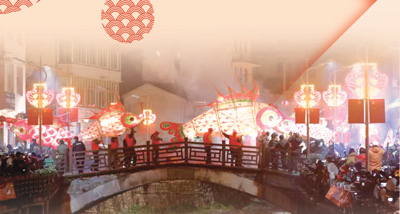
Photo shows a fish lantern parade in Wangmantian village, Shexian county, Huangshan city of east China's Anhui Province. (Photo courtesy of the publicity department of the Communist Party of China Shexian county committee)
Last year, Wang had the lantern-making group create two additional small lanterns specifically for tourists to try out, which sparked their interest. Wang also uploaded the highlights of the parade on social media platforms, reaching a broader audience and receiving numerous likes.
Young man makes traditional Chinese festival food for New Year's Eve reunion dinner
Ge Meng, a young man from Guanxian county of Liaocheng city in east China's Shandong Province, became the chef for his family's New Year's Eve reunion dinner for the first time, for he attended a relevant course at the local youth night school last November.
Ge prepared Huamo, steamed buns with elaborate flowery decorations, along with other dishes including steak and lamb for the dinner. Huamo is a traditional Chinese festival food and also an intangible cultural heritage item.
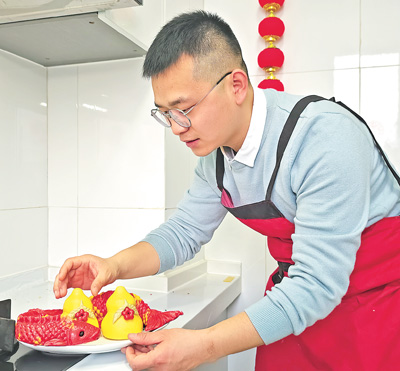
Ge Meng, a young man from Guanxian county of Liaocheng city in east China's Shandong Province, makes Huamo. (Photo/Shi Qingguo)
"Look at these Huamo! How do they look?" Ge asked. His Huamo were shaped like gourds and koi fish. "Huamo represents fortune and prosperity, and abundance year after year," he said.
"Excellent! Your skills are getting better and better," Ge's mother replied as she held the buns, full of pleasant surprise.
"The New Year's Eve dinner symbolizes family reunion. Despite the changing form and content, the essence of the dinner remains the same," Ge said. "I'm eager to be the chef of next year's New Year's Eve reunion dinner!"
Photos
Related Stories
- Chinese New Year Carnival held in Yogyakarta, Indonesia
- Over 2.3 billion interregional trips recorded during Chinese Spring Festival holiday
- Opera House lit up in red to celebrate Chinese New Year in Sydney
- Spring Festival celebrated in Paris
- Sweet encounter between lion dancers and toddler
- China’s 2025 Spring Festival holiday wraps up on a high note, setting new record of 501 million domestic passenger trips
- Imported goods add to festive charm
- Inbound tourism sees record growth during 2025 Spring Festival holidays
- Antarctic Odyssey | Festive Vibes on Xuelong
- Figures see Spring Festival consumption spree
- A glimpse of Yingge dance, folk dance popular in S China's Guangdong
- Inheritors share stories of global recognition of China's intangible cultural heritages
- Shanbei storytelling gains popularity thanks to the perseverance of inheritor
- Woman revitalizes intangible cultural heritage items with a stylish twist
- Intangible cultural heritage inheritor promotes Peking Opera facial makeup painting
- Train themed with local intangible cultural heritages starts operation in Heilongjiang
- Inheritor creates magic with fermented soybeans
- "Clay Figure Zhang" rolls out festive-themed clay sculptures in Tianjin
- Products with Yangliuqing woodblock new year pictures created under inspiration of Year of Snake in Tianjin
- 21-day lantern fair kicks off in Wuzhen
Copyright © 2025 People's Daily Online. All Rights Reserved.






